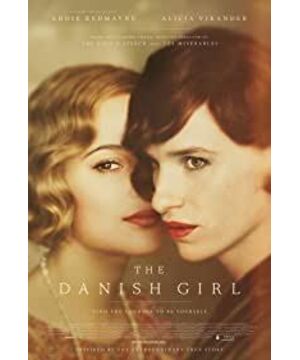Since it's a biopic, I personally think that the basis of evaluation is whether the person in the film has a positive impact on the audience. The protagonist of the play, named Aina, and his wife Gerda are painters, two avant-garde artists in Copenhagen in 1926. Because his wife's model missed her appointment, Aina dressed in women's clothes as a model at Gerda's request. Aina was born a heterosexual. In the case of wearing women's clothes, Lily, who was sleeping in her heart, was awakened. Since then, he has embarked on a thorny road to seek his true self. The whole film is based on the real diary of real people.
Generally speaking, most of us who are influenced by today's rainbow movement will think that this is a film of resistance and oppression, and the main contradiction is the contradiction between the social environment and Aina/Lily. But it's not the case. After watching the movie, I feel that the biggest contradiction in the play is the contradiction between Lily and Aina, that is, whether to pursue the self and to close the self in response to the "needs" of the society, then the core of the discussion will be focused on The struggle between Lily and Aina. Let me just analyze it from the inside of the characters.
If you carefully appreciate the story of Aina/Lily, it is not difficult to find that Lily who pursues the real me so "selfishly" is actually worthy of recognition. In the play, Lily repeatedly refused Gerda's request to "see" Aina, which seemed cruel but was actually for the happiness of the two.
If you can't understand the pain of Aina/Lily, let's think about it this way: both are artists under the influence of new ideas (the political changes in the late 19th century and the industrial revolution caused the advent of adventure and innovation in the early 20th century). Birth), so I still have a certain vision for the future, not to mention Gerda's ability to accept, just from the perspective of husband and wife, the two were very in love with each other, Lili woke up to Gerda after awakening The impact was very violent. Watching her husband turn into her best friend and her love into friendship, but taking care of Lily/Aina with perseverance, this love is heavy. So is Lily/Aina, who is so deeply loved, really hard-hearted? Although the love is heavy, this love has a certain blindness and purpose. Blindness is the ambiguity of Lily/Aina's situation, and the purpose is to hope that Aina will return. Lily/Aina's love for Gerda is very rational, but Lily/Aina, who is not unreasonable, is also strongly condemned by her emotional self. In the face of Gerda's questioning, she tries to find Ai. After receiving no results, she was dejected, and finally she could only choose to become Lily in the pain of endless self-criticism. At the end of the play, Aina's words to Gerda, "How am I worthy of this love?" are literally dripping with blood. I believe everyone will understand how brave Lily was who made this difficult decision.
However, it is such a story that everyone is struggling and twisting inside, which makes me feel very cautionary. At the same time, this story also has many overlapping parts with the gay community. For example, to a certain extent, Gerda is a "same wife", and this tragedy cannot continue. Therefore, I think the Danish girl film is generally positive. For the audience, everyone has the opportunity to see this group that is oppressed by society and self through this window. For this group, it is of great guiding significance to encourage the search for the true self and avoid detours.
Finally, it is worth mentioning that the picture of the film is very "oil". I have always believed that oil paintings use the most solid materials, thick canvases, smeared hard, and the feelings are very real. Therefore, the director deliberately made the film look like a painting, which is also a hint to the pursuit of the true self.
View more about The Danish Girl reviews











